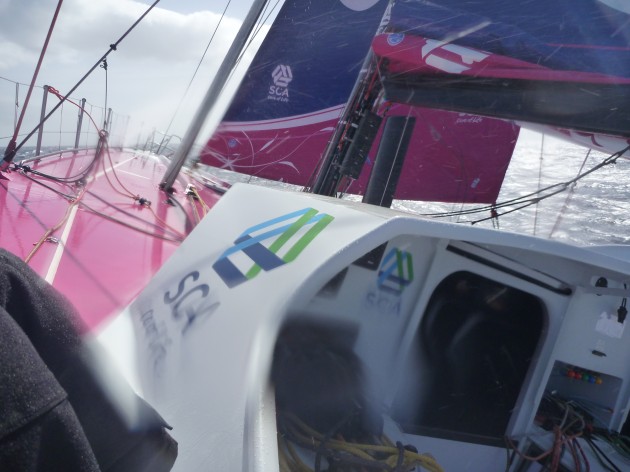What is the new VO65 really like? Here are a few video clips from my first ride aboard Team SCA’s boat in 30 knots
It’s wet, it’s hand held and shaky, but still gives a better view than the naked eye when you’re being battered by green water and spray in 40+ knots of apparent breeze. Here are a few video snippets of my sail aboard the first Volvo 65 as I hooked up with the all women Volvo team in Lanzarote.
Team SCA’s bright pink Volvo 65 is the first of the new generation of VO65s to hit the water. A strict one design for the 2014-15 race, the new boat is designed to combine the best elements of the Volvo 70 with the lessons that have been learned through three generations of the 70 footers.
From the team base in Puerto Calero in Lanzarote we headed out into 30knots to put the new boat through its paces.
On The Rail
Upwind in 25-30 knots meant over 40knots of apparent breeze across the deck at times. What’s difficult to see is the jarring motion of the boat as she piles along at 17knots. The old adage of, ‘one hand for the boat and one for yourself’, needs revising aboard these machines. Having said that, first impressions are of a boat that is indeed more robust than the 70s. She feels more solid and a touch more forgiving when she slams into the next wave. The noise below decks is different too, more of a dull thud than the echoing boom of the 70s that resonated around the empty inner shell. It’s almost as if she’s been clad in sound deadening materials.
Looking Aft
Among the most distinctive features of the new boat is the huge Open 60 styled coachroof designed to give the crew more protection. The new deck structure, which has twin companionway hatches, also sees a new style of control line layout where the halyards and lock controls run down the centreline of the boat.
Looking Forward on Starboard
Slightly cracked and sailing at around 80 degrees true the apparent breeze was still at 50 but our angle to the 2m waves made life a little more comfortable.
From The Bow
The view aft from the bow with the smallest jib (J3) set as we reach back towards Lanzarote. Note the two large deck beams on the foredeck that act as structural members, tunnels for the control lines to prevent sails from jamming them when stacked on the foredeck and of course a decent sized footbrace.
Note also that the J3 is on a furler as is the Solent which is tacked down slightly further forward on deck. Of course the Code Zero is also a furling sail leaving just one the J1 that hanks onto the forestay.
Interestingly, this will have a downhaul line attached to the head so that the sail can be lowered from the cockpit. Life on the foredeck can be brutal and dangerous and it was felt that this was a good way of getting the sail down without risking a crew member.
Take A Tour
Back at the dock, take a walk around the deck of the first of the new breed. Note how deep the cockpit is along with the three winch grinding pedestals, central pit winch and control line arrangement and the angular coachroof that is designed to deflect the considerable amount of water that will be hosing along the side decks before it hits the crew.
Further forward the daggerboards are a simpler and more robust affair than aboard most of the previous 70s with plain bearings and no troublesome doors in the hull. There are no tower structures either. Instead the lifting lines go to a point up the mast before running back to the cockpit.
Note the deck stepped mast and the neat array of control line turning blocks, all easily accessed yet tucked out of the way.
Watch out for our major feature on the boat and the all girl team who are the first to get their hands on the new breed in the January 14 issue of YW.




